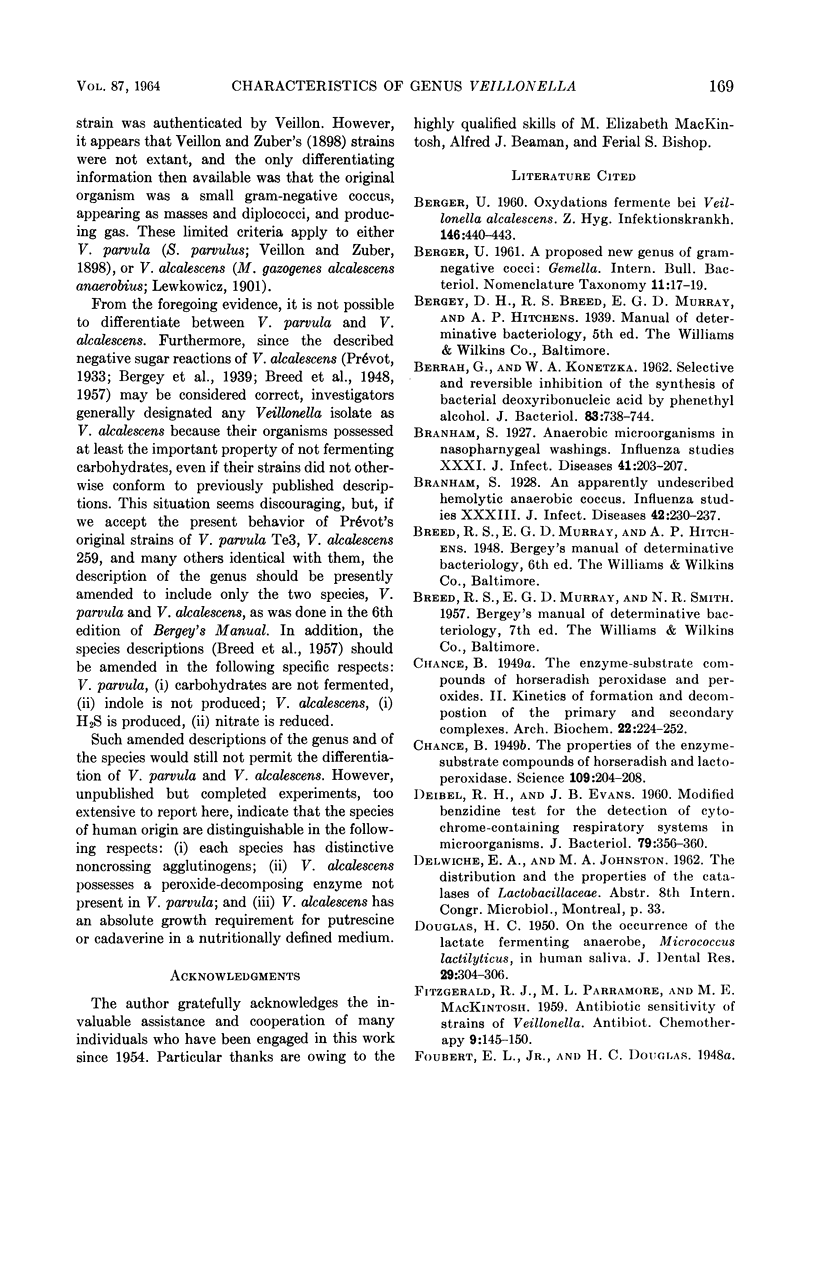Abstract
Rogosa, M. (National Institutes of Health, Bethesda, Md.). The genus Veillonella. I. General cultural, ecological, and biochemical considerations. J. Bacteriol. 87:162–170. 1964.—Arguments are presented for excluding Veillonella discoides, V. reniformis, V. orbiculus, and V. vulvovaginitidis from the genus, and for restricting it to aerogenic organisms such as V. parvula and V. alcalescens. The genus Veillonella thus would comprise species which are anaerobic and nonmotile; are small, spherical, gram-negative cocci appearing as pairs, masses, and short chains; and are cytochrome-oxidase- and benzidine-negative. Veillonella would be further characterized in that glucose or any other carbohydrate is not fermented; indole is not produced; gelatin is not liquefied; nitrate is reduced; H2S is produced; propionic and acetic acids, CO2, and H2 are produced from lactate during growth; and pyruvic, oxaloacetic, malic, fumaric, and succinic acids are metabolized by resting cells, but citric, isocitric, and malonic acids are not. In addition to the above, a number of cultural, ecological, and biochemical characteristics are described. At present, V. parvula (the type species) and V. alcalescens would be retained as valid species. Errors in the descriptions of V. parvula and V. alcalescens are corrected by amended statements. These species are differentiated serologically. Also, V. alcalescens differs from V. parvula in having an absolute requirement for putrescine or cadaverine and in decomposing H2O2.
Full text
PDF








Selected References
These references are in PubMed. This may not be the complete list of references from this article.
- BERGER U. [Oxidation enzymes in Veillonella alcalescens]. Z Hyg Infektionskr. 1960;146:440–443. [PubMed] [Google Scholar]
- BERRAH G., KONETZKA W. A. Selective and reversible inhibition of the synthesis of bacterial deoxyribonucleic acid by phenethyl alcohol. J Bacteriol. 1962 Apr;83:738–744. doi: 10.1128/jb.83.4.738-744.1962. [DOI] [PMC free article] [PubMed] [Google Scholar]
- Chance B. The Properties of the Enzyme-Substrate Compounds of Horse-Radish and Lacto-Peroxidase. Science. 1949 Feb 25;109(2826):204–208. doi: 10.1126/science.109.2826.204-a. [DOI] [PubMed] [Google Scholar]
- DEIBEL R. H., EVANS J. B. Modified benzidine test for the detection of cytochrome-containing respiratory systems in microorganisms. J Bacteriol. 1960 Mar;79:356–360. doi: 10.1128/jb.79.3.356-360.1960. [DOI] [PMC free article] [PubMed] [Google Scholar]
- DOUGLAS H. C. On the occurrence of the lactate fermenting anaerobe, Micrococcus lactilyticus, in human saliva. J Dent Res. 1950 Jun;29(3):304–306. doi: 10.1177/00220345500290030801. [DOI] [PubMed] [Google Scholar]
- Foubert E. L., Douglas H. C. Studies on the Anaerobic Micrococci: II. The Fermentation of Lactate by Micrococcus lactilyticus. J Bacteriol. 1948 Jul;56(1):35–36. [PMC free article] [PubMed] [Google Scholar]
- HARE R., WILDY P., BILLETT F. S., TWORT D. N. The anaerobic cocci: gas formation, fermentation reactions, sensitivity to antibiotics and sulphonamides; classification. J Hyg (Lond) 1952 Sep;50(3):295–319. doi: 10.1017/s0022172400019628. [DOI] [PMC free article] [PubMed] [Google Scholar]
- JOHNS A. T. Isolation of a bacterium, producing propionic acid, from the rumen of sheep. J Gen Microbiol. 1951 May;5(2):317–325. doi: 10.1099/00221287-5-2-317. [DOI] [PubMed] [Google Scholar]
- JOHNS A. T. The mechanism of propionic acid formation by Veillonella gazogenes. J Gen Microbiol. 1951 May;5(2):326–336. doi: 10.1099/00221287-5-2-326. [DOI] [PubMed] [Google Scholar]
- Keilin D., Hartree E. F. The use of glucose oxidase (notatin) for the determination of glucose in biological material and for the study of glucose-producing systems by manometric methods. Biochem J. 1948;42(2):230–238. [PMC free article] [PubMed] [Google Scholar]
- LANGFORD G. C., Jr, FABER J. E., Jr, PELCZAR M. J., Jr The occurrence of anaerobic gram-negative diplococci in the normal human mouth. J Bacteriol. 1950 Mar;59(3):349–356. doi: 10.1128/jb.59.3.349-356.1950. [DOI] [PMC free article] [PubMed] [Google Scholar]
- LILLEY B. D., BREWER J. H. The selective antibacterial action of phenylethyl alcohol. J Am Pharm Assoc Am Pharm Assoc. 1953 Jan;42(1):6–8. doi: 10.1002/jps.3030420103. [DOI] [PubMed] [Google Scholar]
- MERGENHAGEN S. E., HAMPP E. G., SCHERP H. W. Preparation and biological activities of endotoxins from oral bacteria. J Infect Dis. 1961 May-Jun;108:304–310. doi: 10.1093/infdis/108.3.304. [DOI] [PubMed] [Google Scholar]
- ROGOSA M. A selective medium for the isolation and enumeration of the veillonella from the oral cavity. J Bacteriol. 1956 Oct;72(4):533–536. doi: 10.1128/jb.72.4.533-536.1956. [DOI] [PMC free article] [PubMed] [Google Scholar]
- ROGOSA M. Experimental conditions for nitrate reduction by certain strains of the genus Lactobacillus. J Gen Microbiol. 1961 Mar;24:401–408. doi: 10.1099/00221287-24-3-401. [DOI] [PubMed] [Google Scholar]
- ROGOSA M., FITZGERALD R. J., MACKINTOSH M. E., BEAMAN A. J. Improved medium for selective isolation of Veillonella. J Bacteriol. 1958 Oct;76(4):455–456. doi: 10.1128/jb.76.4.455-456.1958. [DOI] [PMC free article] [PubMed] [Google Scholar]
- ROGOSA M., HAMPP E. G., NEVIN T. A., WAGNER H. N., Jr, DRISCOLL E. J., BAER P. N. Blood sampling and cultural studies in the detection of postoperative bacteremias. J Am Dent Assoc. 1960 Feb;60:171–180. doi: 10.14219/jada.archive.1960.0030. [DOI] [PubMed] [Google Scholar]


